The other day I was turned down as an applicant to a local art co-op. I was applying as a painter, not a textile artist, had made the first cut, and was asked in for an interview. After the interview, the group decided I should “try again next year.”
Aside from the obvious reasons for the rejection (the quality of the work itself and splits of taste within the co-op group), I realized that I had gone to the interview unprepared for what I found.
The Co-op saw the interview as an application for an exhibit or a job; I saw it as an act of collegiality and a conversation.
Here’s a review of the process and my thinking about it.
I was told to bring some of my “most recent work” (which I interpreted as “most raw”), so I pulled out a pleine aire, a few days old.
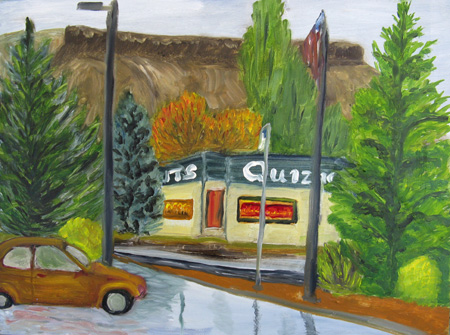
Quiznos Subs, Prineville, Oregon
I thought I would talk about various directions my art tends to go, so I took in a couple of abstracts:
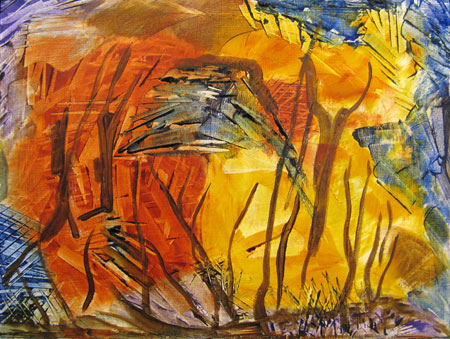
Growth
a “standard” landscape:
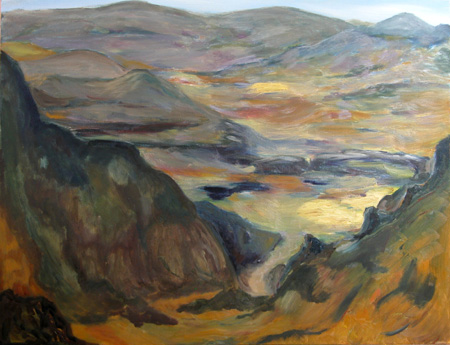
Steen’s Mountain
and 4 pieces from the series depicting the trashy scene on McLoughlin Boulevard:
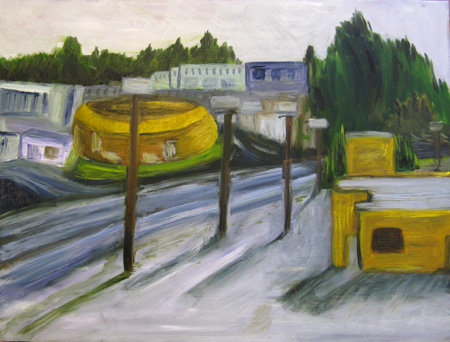
McLoughin Boulevard, 5 AM
None of what I showed was framed; many of the pieces I would describe as still “in progress” — i.e. likely to be tweaked later.
Showing a variety of modes (landscape, urban-scape, abstract) was a mistake. And taking in paintings still in process was another mistake. Finally, without framing, the group couldn’t assess the work as it will appear in exhibit . All this I understood or was told by various members of the co-op, who reassured me that I really should try again next year. So that was OK. But a different question occurred to me:
Why would I have thought of this appearance as “show and tell” rather than a more formal application mode? Once I got over my disappointment, that was the question I pondered. For I know and fully accept to all the white-glove advice about showing only your best work, putting your best foot forward, etc. I squampfel about the strictures, but have been around long enough to have gotten over my rebellion at the strictures. So my error of judgment this time puzzled me.
I came to realize, however, that I was imagining the co-op group as colleagues, giving input on work-in-progress, rather than as curators or gallery owners. And that, in part, probably came out of my experiences in writing (both my own and through the experiences of family and friends who are writers). In writing, nothing is final until the book comes off the press. No group expects the “reading” to be a final product; no editor imagines that the manuscript, however clean, will be the final edited version.
The end processes of writing, it turns out, are far more collegial and communal than is the case with the visual arts. A writer expects, nay begs, for a copy editor to find the misplaced comma and the erratic spelling. But the visual artist would be devastated if someone came along with a brush and added a dot of Naples yellow to her field of daisies. Once a visual artist has declared her work finished, no one would dare to touch it. But when the writer sends off the work to her publisher, she expects to have revisions suggested or demanded, paragraphs deleted, sentences rearranged, and discussions ad infinitum about what more should be done. All that comes before the actual copy editing by the comma-splice person.
Some time ago, Jay made an off-handed “admiring” remark about my willingness to show work in progress. I thought it a strange thing to say, since the paradigm in my mind was of readings by authors of work-in-progress, not of applications to museum curators. I was thinking of Clement Greenberg, visiting the studios of the Ab Ex artists in the 50’s and turning canvases around that were facing the walls, saying, “no. No. No. Yes!.” But Jay’s training is as an academic, and so, perhaps, showing work in progress has long had a hint of the amateur, the outsider, about it — if the collective mind, the “audience” the students and professors, want to see only finished work, the raw stuff will seem naive or immature. There also may be an element of competition to this process, one that goes back at least as far as the Renaissance (Rubens and Rembrandt, for example) but which also may be fostered by academic hothouse of universities and art schools.
Groups like A&P, however, take an entirely different approach to the act of making art. Here, collegiality extends to allowing each other to play around with our images, photoshopping them to see what else could happen.
And, this emphasis on creativity, now part of most public school art training, is obvious when I’m painting outside. Invariably, when I’m outside, a child will come up and look and say, “nice job!” (This remark is sometimes comic in that I can be accosted when I’ve scarcely put a line of paint on the board.)
Adults tend to use slightly different but still encouraging language — “Looking good” “You’re almost there” — phrases which come from the amateur road races and jogging events that pervade the U.S. culture. These are charming encounters, and entirely different from the analogy of job applications, where the stone faced critic examines one’s color and form and shapes and paint handling and techniques and presentation as well as one’s age and rhetorical style — and then says, “We’ll call you.” Luckily, I don’t apply for jobs any more. Unluckily, I misunderstood some of the conventions of the visual arts.
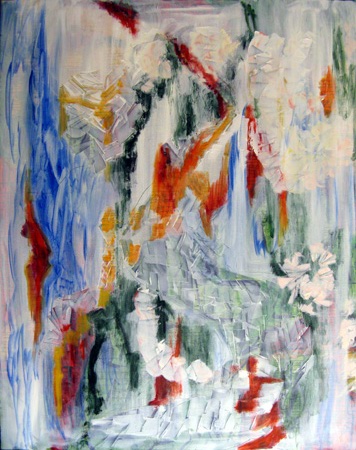
Big Vase (work in progress, an abstract that was once turned another way)
Do you see differences in the way arts are judged? Music played by performers, for example, is supposed to be utterly polished before being presented to the public. But theater has its try-outs in Bridgeport before it goes to New York. Unfinished sculptures, like unfinished symphonies, are only “unfinished” in some technical sense of the word. “Reading from the manuscript” is totally acceptable; are there similar try-outs in dance, for example?
And, further, have you ever mis-understood the context in which you were presenting yourself because you had a perfectly good but misplaced analogy that you were using to prepare?

June:
I’m so pleased to learn that I have been elevated to the status of academic. I have sometimes come across as anemic and have eaten macadamia nuts, but that pretty much closes the book on my credentials. Unless there’s another Jay out there…
Does this count? As director of a small nonprofit program I was invited to attend a get-together of federal employees. I showed up with visions of cheese and crackers and polite chat to discover a large room full of individuals waiting for the appearance of the main speaker – me. Fortunately I had a practiced line of patter to fall back upon and I don’t think people picked up on my shock.
And gallery owners ( I cannot bring myself to use the term “gallerist”) have been known to ask me not to let the door hit me on the butt on the way out.
A painting is merchandise and is regarded as such by a person whose business prospects are influenced, in part, by its saleability. This site is a different animal in that its membership tends not be be in sales mode, and rather enjoys discussing issues that the presented images and artifacts illustrate.
June,
I imagine the nature of the gallery as a “co-op” played a role in setting your expectations. The word naturally suggest supportive collegiality, and that might well be what you would find if you became a member. And given those expectations, I think you chose an appropriate and interesting diversity of paintings to show them. But their first priority, or at least their filter for potential members, is apparently the production of finished, quality work. That was explicitly stated in an interview of a co-op gallery that I did for my Art Bozeman blog. But it can be hard for artists to know what’s expected by all the different sorts of galleries or exhibit venues, which is why I’m doing the interview series.
I think it’s incredibly difficult to find or establish a congenial discussion/support/critique group. Have you by any chance tried one of the art Meetup groups in the Portland area, e.g. the Portland Artist’s Way Meetup? I would guess these are unlikely to suit your need exactly, but they might be a way to find others also looking for a smaller group.
I like your Growth painting. Despite the title, I think of a conflagration. As the 20-year retrospective articles are pointing out, there’s been lots of growth in Yellowstone since the great fires of ’88.
Hi Jay,
I didn’t mean to out you as an academic — it’s only that I know something of your checkered past. But macadamia will do. As will showing up to engage in polite chatter and discovering yourself as the keynote speaker. Of that, nightmares are constructed. I’ve had those nightmares, even though I’ve never had precisely that experience.
Steve, you may be correct that “co-op” was a word I misinterpreted. It wouldn’t surprise me.
I do have various art groups here in Portland — let’s see — a textile art critique group that meets once a month, an eclectic group of 3 other couples who engage in various arts and meet once a quarter, a painting critique group that meets once a month….
I was, selfishly, hoping the co-op would save me from the debilitating search for galleries and exhibit opportunities. That process, for me, is so fraught with energy drains (emotional and physical) that I thought the co-op route would be the way to go — guaranteed exhibit every couple of years and congenial colleagues to boot.
I’ll look into the Artist’s Way meetup. However, if they are the “Artist’s Way” book group, I probably won’t find them useful. The (book) “Artist’s Way,” as I understand it, having read about two pages of it a long time ago, is really about commitment to the act of making art and getting over one’s fears about the process. These are not my problems…..
I too like “Growth.” I’m trying to suss out more about abstract painting, hoping to bring it somewhat closer to something like “control” or ability to produce decent abstracts a bit more regularly. I can’t seem to produce much like “Growth” on any regular basis although I have a ton of abstract pieces sitting around waiting to be overpainted. One of my sources says that abstracts are all about color, form, and texture. That doesn’t seem to me to be quite enough. But then, I’m not exactly in a position to comment….
June,
You are brave to explore different worlds. It is probably one of the best ways to remain alive.
Everyone’s different taste! Troels loves the ‘simplicity’ of picture 1. I like the juxtaposition of the solidity of the structures with the reflection in the road. It reminds me of a ‘change’ of an observation at the Bremen airport. I first noticed a row of large columns defining a walk through the airport and only later their reflections in the shiny flooring. I checked this change in observation (can it be called perception?) with Troels by asking him to look in the direction of columns and then, sometimes later, whether he had noticed their reflections. He had not! But when alerted to them, he found them very interesting. Do people first notice only the obstacles in their path? Does this limitation in their observations have to do with the environment? Having gone through a security check might make one more perceptive of further obstacles to bump into.
We both like painting 3. The flow of the hills has a great rhythm.
In Picture 2, Growth, I like the colors but not the ‘abstract’ flatness. In picture 3, I like the feeling of the flow of the street but, for me, this flow does not jive with the buildings. The last picture reminds me of the ice palace of your winter in Montana where you tried to finish all your tubes of white before leaving.
With respect to try-out, I wonder why music does not fall into same category as theater and writing. All three strike me as equably malleable. I am not surprised that painting is different because adding a brush stroke of yellow may not be as easily undone as changing a sentence, a note or an interpretation of a script. This reminds me of Walter Bartman encouraging Leslie Holt several times to add more red to her painting until she finally understood what he meant and did it and liked it. Thus, he did not add the color himself but was very persistent in asking her to consider doing it.
June,
Now that you understand what they wanted from the interview, would it be well to say that and ask to speak to them again before a year has gone by? Or have you soured on the thing? The way you engaged with the interview sounds to me like an echo of your previous post or comment about wanting a mentor in painting.
Somewhere in my ancillary-material files I have a NYT article that I sometimes use in my writing class. It’s called “Take My Revised Dances, Please” and it’s about developing a dance piece through workshop, rehearsal, perfomance, feedback, rinse-and-repeat. I use it when I have a group that’s oriented toward process as process — otherwise it sparks a converstation about how “dance is different because…” whereas what I’m usually after is how certain things are the same across the disciplines and that we should be heartened by that.
And, just btw, a writer should expect a good deal more from a copy editor than for “a copy editor to find the misplaced comma and the erratic spelling.” That’s not any kind of editing, that’s proofreading. (I will now climb down from my hackle.)
Birgit,
Thank you for the careful looking and commentary. The reflections were a specific result of working pleine aire (although since I was inside a motel doorway, the air was not as pleine as one could have wished.) The McLoughlin Boulevard is one that will be tweaked — I want to make the buildings more wonky, rounded and tipsy (like the ones on the left) to echo the street. You have a good eye!
And the last one, like ice, is going through further modifications — I reworked it extensively last night — with leftover paint (not white, though.)
Melanie,
My apologies for denigrating the serious work of editors in general and copy editors in specifics. I live with one, and he is right now,as a result of my misstatements, tearing out the two hairs he has left. So my apology is sincere and abject, else I lose my happy home.
Copy editors are the blessing of my existence — and not just around the house. They save my hide, again and again, and allow me to be feckless as well as keeping me up to snuff. So indeed, copyeditors do more than proofread; they provide the underpinning of truth and standards that the world requires if it isn’t to go entirely to hell in that rusty handbarrow.
As for returning to the co-op group and re-applying — well, one’s pride is always a factor, isn’t it? And mentoring is difficult to come by in any deliberate manner. But, at least to my conscious mind, it was the exhibiting that I was seeking from the coop. Traipsing around town carrying paintings hither and yon looking for a gallery to accept them is painful; the inevitable rejection is only part of the pain. AT 66, I’m too old to carry canvases down a crowded street. So I was hoping to avoid that grueling task and still have regular exhibits.
That said, I am right now working on a tiny exhibit for the Oregon Paleolands Institute, out in Fossil Oregon. The exhibit is tiny because the space is small, but it is a grand way to achieve focus. And to get some work finished!
Which brings me around to the opening topic: exhibiting is very like thinking about being copy edited — it add incentives to finish one’s collection of flotsam and jetsam, and not leave the clauses dangling nor the buildings unwonked. One has one’s pride….
Thanks for checking in.
There is no shame in misunderstanding something that seems to have been at least somewhat unclear, and much credit in standing up for what you want.
They like your work enough to invite you for an interview.
They did look at what you brought and say “please come again.”
Unless they’re a lying pack of miscreants — in which case you’re well out of it — it would be as practical of you to give them another chance with you as it seems you think it would be kind of them to indulge you with another audience in a year’s time.
Humbug.
They need work to show. They need that now.
You have work to show. You have that now.
That’s all that’s going on here. If you wait until next year, who knows what will have shifted in the interim. There’s room for renegotiation, I’d think. And if they still decline your application, then you have the pride of having given it your best shot.
I know it isn’t easy to keep your feelings out of it. I stopped writing because I don’t enjoy it enough to do it for it’s own sake and, once having written, I can’t manage the emotional component of interacting with the publishing industry. I don’t regret giving it up; other things have arisen that are equally engaging and infinitely more joyful.
I tell my students this All The Time — publishing is a business, not a club. It’s lovely when you happen upon a business environment that is collegial, but that’s not the point of the exercise. As the saying goes — it’s not personal, it’s business.
Whew! I feel like I’ve been given a strong backbone stiffener. Oddly enough, I feel the same as you about writing, which I once did for far more formal venues. But I haven’t reached that stage of disillusionment with exhibiting my painting yet. Both the work and the final product still seems like fun — well, mostly like fun.
On the other hand, here you are, writing to A&P — which, as far as I’m concerned is a whole lot more fun than any formal publishing venture I ever tried.
Thanks, Melanie
Just call them. Maybe read this bit by Roethke and then call, but do call. Misplaced pride cuts us off from too much in lives that are too short to begin with.
Take the lively air.
The Waking
Theodore Roethke
I wake to sleep, and take my waking slow.
I feel my fate in what I cannot fear.
I learn by going where I have to go.
We think by feeling. What is there to know?
I hear my being dance from ear to ear.
I wake to sleep, and take my waking slow.
Of those so close beside me, which are you?
God bless the Ground! I shall walk softly there,
And learn by going where I have to go.
Light takes the Tree; but who can tell us how?
The lowly worm climbs up a winding stair;
I wake to sleep, and take my waking slow.
Great Nature has another thing to do
To you and me, so take the lively air,
And, lovely, learn by going where to go.
This shaking keeps me steady. I should know.
What falls away is always. And is near.
I wake to sleep, and take my waking slow.
I learn by going where I have to go.
“I wake to sleep and take my waking slow….”
What a lovely line.
And, “I learn by going where I have to go” is, for me, the ultimate truth.